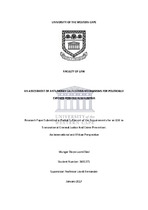| dc.description.abstract | Money laundering is a practice 'as old as money itself'.1 In 1931, after the conviction of Al
Capone for tax evasion, there was a noticeable trend in the use various methods to
camouflage assets deriving from crimes. Indeed, the practice of money laundering became
not only more prevalent, but also more detectable. However, the term "money laundering"
was used for the first time in connection with the Watergate Scandal in the United States,
when the Republican Party channelled money obtained illegally via Mexican banks to fund
its election campaign. In 1986, the US Congress adopted the Money Laundering Control Act
to criminalise money laundering. The US recognised that, having an international character,
money laundering could not be combated with domestic laws and controls alone, and that,
being the only country implementing strict regulations, the US had placed itself in an
economically disadvantageous position. Therefore, the US brought the issue of money
laundering to the attention of the international community. | |

